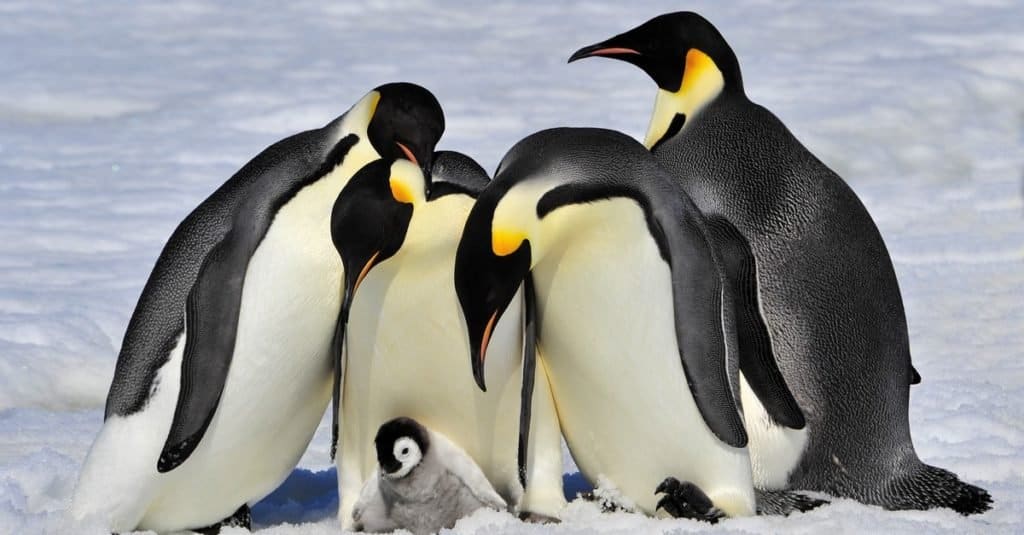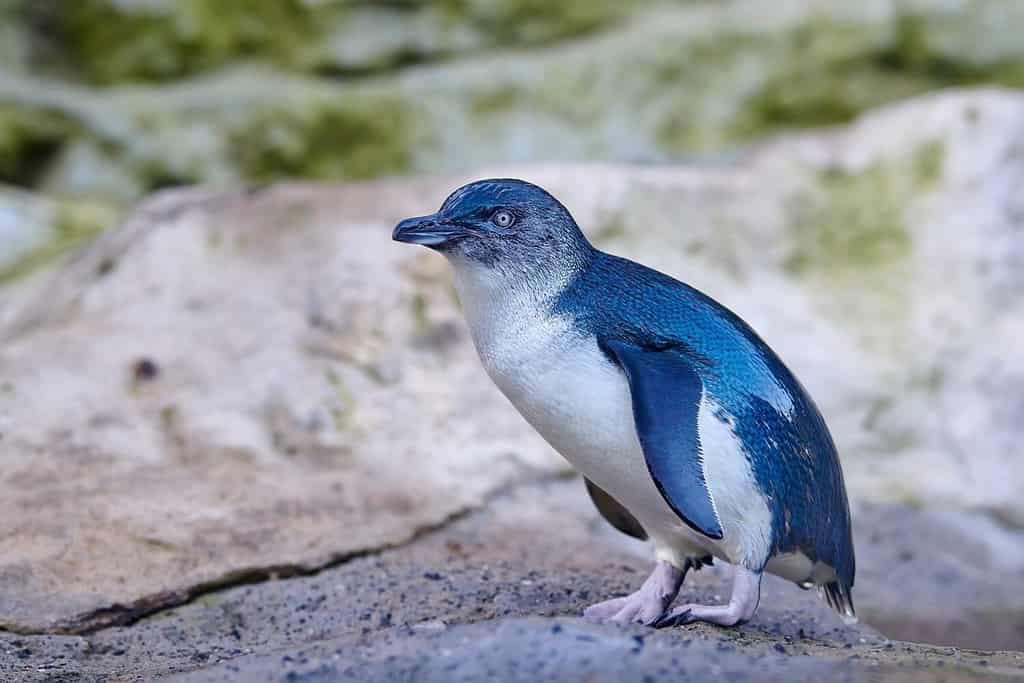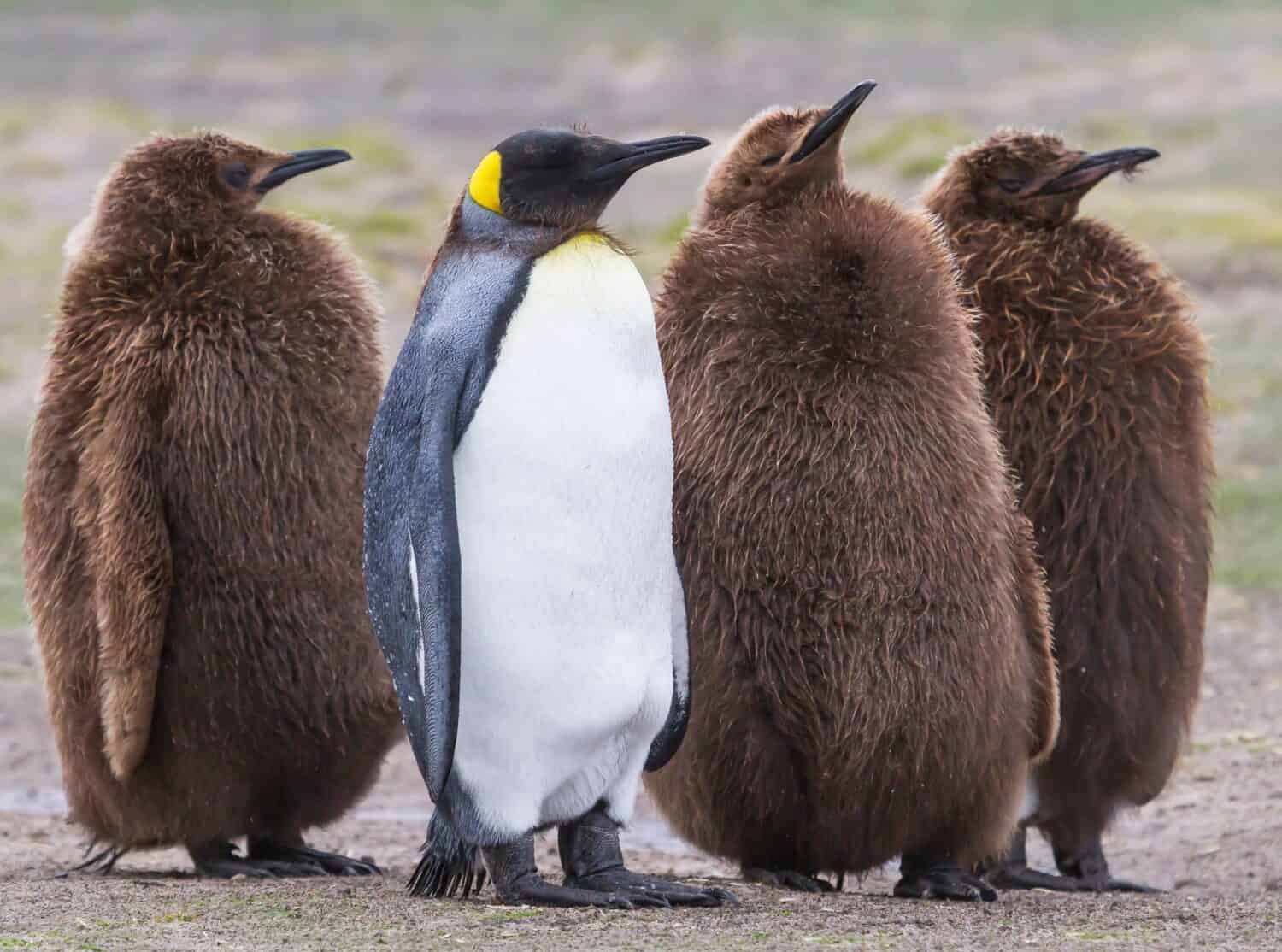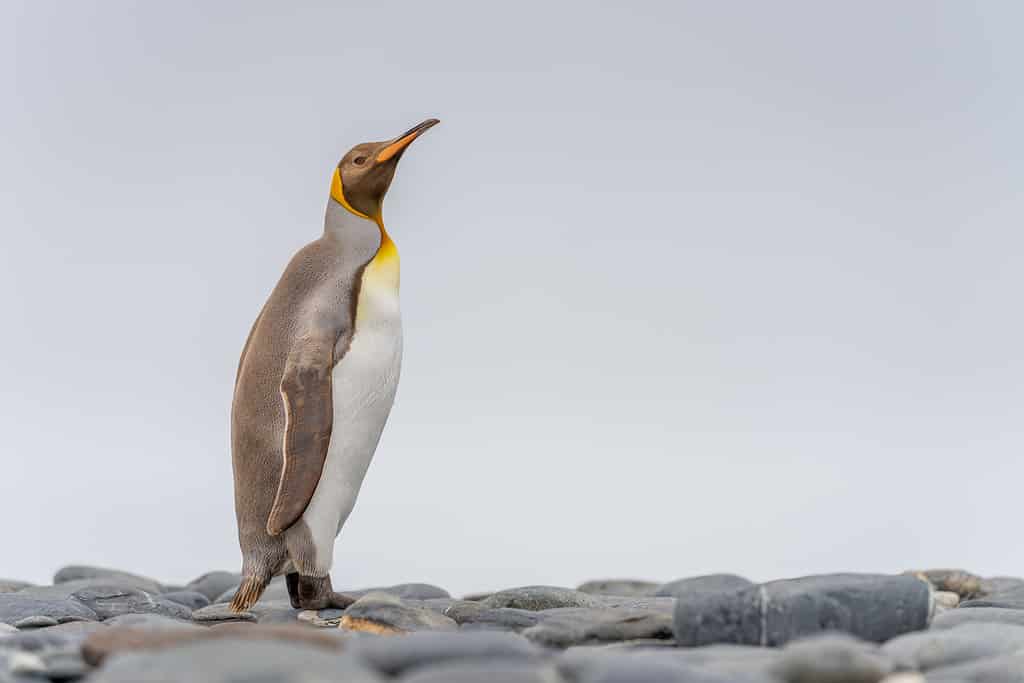Penguins (Spheniscidae) are famous for their black and white plumage, a classic example of countershading camouflage. But where do these colors come from, and what other colors can you find in the penguin world? Read on to find out!
Black and White (and Gray)

Both this
Adelie penguin (Pygoscelis adeliae)
chick’s gray feathers and its parent’s black feathers are thanks to eumelanin.
©Sandra Ophorst/Shutterstock.com
With just one exception we will get to in a moment, every living penguin species is primarily black and white. Indeed, this classic “tuxedo” plumage is one of the key features that define the family as a whole!
The blacks seen on adult penguins, as well as the grays seen on some of their chicks, come from biological pigments known as melanins. There are two types of melanin. The first is eumelanin, which produces blacks and dark browns. The second is pheomelanin, which produces lighter browns as well as ruddy reds and sandy yellows. These are the same pigments that give us humans our range of hair and skin colors! While there is fossil evidence that some ancient penguins may have had pheomelanin colors, modern penguins just have eumelanin. Lots of eumelanin produces black feathers; diluted amounts produce grays; and a lack of melanin leaves feathers white.
Yellow and Orange Highlights

While
emperor penguin
chicks are just black, gray, and white, adults show off some yellow and gold patches thanks to spheniscins.
©vladsilver/Shutterstock.com
Besides just black and white, several penguin species also have yellow and gold highlights on their heads, faces, and/or necks, including the great penguins (Aptenodytes spp.) and crested penguins (Eudyptes spp.). In most birds, these colors come from carotenoid pigments obtained through their food. Penguins, however, do it differently. They can actually produce their own unique penguin yellow pigments! Scientists have named these pigments spheniscins, after the scientific name of the penguin family.

These northern rockhopper penguins (
Eudyptes moseleyi) also have spheniscin pigments to thank for their fabulous frocks.
©Darcy Jardine/Shutterstock.com
Blue

Little blue penguins are endemic to New Zealand.
©Alamin-Khan/Shutterstock.com
The one exception to the black and white penguin tux dress code is the smallest penguin species, the appropriately named little penguin (Eudyptula Minor). These penguins sport a unique slate blue color where every other penguin is usually black, giving them their other common names of blue penguin and little blue penguin.
The little penguin’s beautiful blues are not biological pigments, but rather structural color produced by a neat optical trick. Similar to how the sky and ocean can also look blue to us, these birds’ feathers refract light in just the right way to appear blue to our eyes. In fact, simply don’t exist in the bird world, so every “blue” bird you see uses this same trick of structural color to fool your eyes!
Brown
Baby Browns

King penguins go through a dramatic wardrobe change when they molt from juvenile to adult plumage!
©Farjana.rahman/Shutterstock.com
In some species, such as king penguins (Aptenodytes patagonicus), juveniles are covered in downy brown feathers. When they molt into their adult plumage, they will transform into their black and white tuxes. As with black and gray, these dark browns come from eumelanins.
Mutated Browns

This Adelie penguin appears to have the brown mutation, as its normally black feathers are instead coffee brown.
©flammulated/ via Getty Images
Sometimes, an adult penguin can also have brown rather than black feathers. This is usually caused by a mutation, known simply as “brown.” The brown mutation impacts eumelanin synthesis by reducing oxidation levels. This, in turn, causes normally black feathers to instead be brown.
Melanin Mutations
Besides the brown mutation described above, both melanin production and deposition can be altered by other genetic mutations. These mutations may occur in only certain areas or throughout the body. A number of different mutations have been recorded in individual penguins across species. It should also be noted that in cases where penguins also have spheniscin pigments, their yellow and gold highlights would not be impacted by such mutations (but could, instead, be impacted by other mutations specific to those pigments).
Hypermelanism

This king penguin gang includes a rare melanistic individual.
©Gerald Corsi/ via Getty Images
When an excess of melanin pigments exists, feathers that are normally white or gray can instead become black. This mutation is known as hypermelanism, or simply melanism.
On the other end of the scale, when less than the normal amount of melanin exists, normally dark feathers can instead become light or white, as seen below.
Leucistic

This
Magellanic penguin (Spheniscus magellanicus)
displays a classic case of leucism, with much of its black feather pigmentation missing.
©Michael Vi/ via Getty Images
When melanin pigments are absent altogether, white feathers result. Sometimes, this only occurs on a single patch or even a single feather; other times, it may occur in patches across the body, a condition commonly called piebald; and rarely, it may impact all feathers, resulting in a white bird. While such birds may be mistaken for albinos, their dark-colored eyes usually give them away; leucism does not impact eyes and bare parts.
Diluted

This king penguin’s normally black feathers look unusually gray due to a melanin dilution mutation.
©Frank Günther / via Getty Images
Sometimes, rather than pigments being entirely missing, they are just diluted, causing a washed-out appearance. There is a suite of terms associated with different specific forms of dilution, including hypomelanism, pastel, isabelline, and ino, though it can often be difficult to know for sure which mutation an individual penguin has just by sight without genetic testing to confirm.

The
gentoo penguin (Pygoscelis papua)
on the right has a melanin dilution mutation that results in an all-over washed-out appearance.
©Alexey_Seafarer/ via Getty Images
Albino

Snowdrop was an
African penguin (Spheniscus demersus)
from the Bristol Zoo who was a true albino; note the lack of pigmentation even on the beak and the red eyes.
©Arpingstone / CC0 – License
Unlike total leucism, a truly albino bird will be missing melanin pigments throughout its body, not just on its feathers. This results in light-colored bare parts and eyes that may appear either red or icy blue depending on how the light hits them. True albino penguins are incredibly rare.
Conclusion
Yes, penguins are for the most part black and white. But there are also other colors in the mix, including gray, brown, yellow, and gold, and for one species, even blue. In addition, melanin mutations can cause color aberrations, resulting in abnormally black, brown, or white individual penguins.
| COLOR | SOURCE |
|---|---|
| black, gray | eumelanin |
| white | no pigmentation |
| brown | eumelanin |
| blue | structural color |
| yellow, gold | spheniscin |
The photo featured at the top of this post is © Vladimir Strnad/Shutterstock.com
Thank you for reading! Have some feedback for us? Contact the AZ Animals editorial team.






